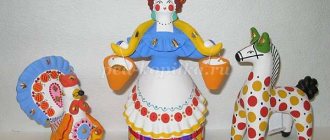History of the Dymkovo toy
Let us preface the story about the Dymkovo toy with two significant facts:
- it has been made by craftsmen for over 400 years;
- These figures are known and loved not only in our country, but also abroad.
Dymkovo toys (pictures)
The pictures below will help you fully imagine the diversity and beauty of the Dymkovo toy.
The name of the craft was given by the Dymkovo settlement, where these clay figurines began to be made. For a long time this settlement has been part of the city of Kirov, which formerly bore the names Khlynov and Vyatka.
|
The great demand for clay crafts, as well as the presence of large reserves of this natural material, made Dymkovskaya Sloboda the birthplace of the famous folk craft. Of course, the appearance of the first crafts was far from canonical, but over time, the familiar appearance and ornamentation of the Dymkovo toy was formed.
The appearance of the first clay crafts in Dymkovo dates back to the 15th-16th centuries. By this time, the toy loses its sacred meaning, which determined the simplicity of its form: the pagan worldview of the Slavs and pre-Christian rituals are a thing of the past. The shape of the products begins to change, they become beautiful and colorful.
The traditions and manufacturing techniques of the first masters have been preserved to this day. The Dymkovo toy known to us today reflected elements of Russian life of the 19th century; later images of gallant gentlemen and fashionable ladies appeared.
|
Craftswomen of that time not only preserved old traditions, but also brought newness to the appearance of clay crafts, and also came up with new subjects. So craftswoman E.A. Koshkina has achieved great success in creating group compositions. Her work “Sale of Dymkovo Toys” was presented at the international exhibition in Paris in 1937 and received great fame. Craftswoman O.I. Konovalova (daughter of A.A. Mezrina) liked to create images of animals, and craftswoman E.I. Penkina preferred to embody everyday scenes in her compositions.
At the beginning of the Great Patriotic War, the production of figurines practically ceased: the Kirov region was in the rear, and its residents began to work for the front. However, the evacuees really liked the bright crafts, and the craftswomen began creating them again.
Dymkovo fishery in the 21st century
No matter how technology develops, the famous craft still remains manual. Masters create toys, carefully preserving ancient traditions. Therefore, each figurine is unique.
Dymkovo toys have been made for centuries and remain popular, being not only souvenirs, but also guardians of folk memory, a symbol of Russian folk culture.
Currently, both enthusiasts and various organizations take care of the preservation of the famous folk craft. In 2010, in the center of Kirov, with support, a monument dedicated to the Dymkovo toy was erected. It represents a family consisting of a mother with a baby in her arms, a man playing the harmonica, a boy with a whistle, as well as a cat and a dog. All figures are made in the classic Dymkovo style.
The Dymkovo toy was among the treasures of Russian art presented at the opening of the Winter Olympics in Sochi in 2014.
System of images and plots
If we compare the surviving images of the first products with modern examples of this folk art, we cannot help but notice that over hundreds of years their creators have stepped far forward. The toy got rid of the simplicity of its form and ornamentation and became more decorative, and the number of plots increased significantly.
Although craftsmen claim that no two figures are absolutely identical, five main typical groups can be distinguished:
- Female images (young ladies and mistresses, nannies and nurses with a child in their arms, water bearers). The ladies have corsets and crinolines, umbrellas in their hands, fashionable hats and outfits; nurses in kokoshniks, wide skirts, aprons with frills. Static figures full of majesty and dignity.
- Cavaliers are often depicted on horseback in profile. Compared to women's images, they are smaller in size and look simpler.
- Animals . Initially, figurines were created depicting totem animals: a ram, a goat, a deer, a bear, and images of various domestic animals were gradually added. A distinctive feature of this type: an upturned head and short legs, widely spaced. Often the figures are “dressed up” in bright colorful costumes of musicians with instruments in their hands.
- Birds (roosters, turkeys, ducks). Ducks have lush capes, roosters and turkeys have bright, curly tails.
- Compositions . They can include both people and animals. They present various scenes from Russian city and village life: tea drinking, folk festivals, sleigh rides and many others.
A distinctive feature of Dymkovo toys is that they expand at the bottom. Ladies have fluffy bell-shaped skirts, gentlemen have horses, and animals have stable legs. If the figures had thin, long limbs, they would not have been able to withstand the weight of their body.







